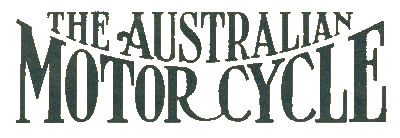


Manufactured by Russell, Walsh and Hitchcock, of 263 Cardigan Street, Carlton, 1919-c.1922
An experienced manufacturer of bodywork - petrol tanks, mudguards and the like - William and Isaac Walsh built a prototype in late 1919 powered by a 3½ h.p. twin-cylinder two-stroke. This was followed by two large V-twin four-strokes of 7-9 h.p, which were raced by the brothers Ike and Nick Walsh. These were A series machines - a B series was built somewhat later with a larger engine. It has been suggested that at least one of the engines was a Pope.
In May 1920 the Aussi Also Motors & Manufacturing Company Ltd was formed, with advertising suggesting that a large, modern factory and substantial workforce were ready for production. This was far from the truth.
They further claimed, in June 1920, that 40 motor bicycles were under construction, and that the factory could produce 25 machines each month with a workforce of some 50 employees.
It seems few believed them. The company failed shortly thereafter, and the few completed machines and associated workshop machinery were sold off.
Sources: wikiwand.com, The Motor Cycle, Trove NLA, et al.
Australia Enters the Manufacturing Field.
Two Motor Cycles produced in the Antipodes,
By Our Australian Correspondent.
AUSTRALIA is to produce its own motor cycles. True, only a few firms have started to make machines, but if they are successful others are bound to follow suit, and a field for export trade will gradually be lost to both American and British manufacturers.
One of the Australian produced machines is known as the Aussi-Also, is all-Australian, and the price mentioned in its connection is so low that without doubt it would have a strong appeal with British motor cyclists.
The machine has shaft drive, a large four-stroke engine, and sells at £60. In laying out the machine the designers have certaily departed from the accepted practice of both Great Britain and America, although externally the products of the latter country have been followed. Mechanically, the machine breaks new ground by having the gear box embodied in the crank case of the two-stroke engine, and by driving with a shaft and worm.
A Large Two-stroke.
The machine was on view in the exhibition of Australian Industry. It is advertised as designed by Australians, built by Australians, for Australians. The engine is a large two-stroke, about [?]h.p. by English rating, but it is claimed to develop 7 h.p. This type of engine is adopted for its simplicity, as the average "Aussie" is a slap-dash individual not accustomed to fine machinery. The crank case incorporates the clutch and two-speed gear, the whole of these moving parts therefore running in oil. The engine and gear box unit is placed longitudinally in the frame, and the drive is taken from the layshaft of the two-speed gear to the rear wheel by shaft via a universal joint; it is therefore unaffected by wet when fording streams. The final drive is by enclosed worm gear (via another universal joint).
Close Gear Ratios.
The clutch is of the cone type, Raybestos lined, of very generous dimensions, and the two-speed gear is of the constant mesh, dog clutch variety. The top ratio is 4¼ to 1, and the second 6¼ to 1. This is one of the few points open to criticism in the machine. A lower second gear ratio would seem advisable, especially if a side-car is to be fitted. It must be noted, however, that this model is not designed for sidecar work, a more powerful model with twin cylinders arranged tandem fashion (car practice again) being in process of evolution for this purpose.
The Delco system of combined lighting and ignition is fitted as standard, the dynamo taking the place of a magneto.
The present price of the machine is £60, which, if it can be maintained, should cause English manufacturers with their present high prices to look to their laurels. A large factory for mass production has been erected, but labour troubles at present prevent it working to its full capacity, and delivery cannot be promised within four months of date of order.
(The second part of the article is about the Pasco)
Source: The Motor Cycle , July 29th, 1920. Page 133
No little interest is being manifested in motor-cycling circles in an all-Australian built machine to which has been given the name "Aussie-Also." It was designed and is manufactured in Melbourne, and pos-sesses many points of interest. The engine is of the two-stroke type, with a bore of 3in. and a stroke of 4in. developing 7-h.p. The transmission is first to an enclosed cone clutch, thence through a two-speed gear-box to a final shaft and worm drive, which is guaranteed for 5,000 miles. The ratios of the gears are 4¼ to 1 on top, and 6¼ to 1 on low. The electrical equipment (generator) supplies ignition and lighting, but a magneto will be fitted if desired. Although the machine has 28in. wheels (and 3in. tyres) it is low-built, with a long wheel base, which should make for easy riding, while the general design shows simplicity. The most interesting feature just now perhaps is the comparatively low price at which it is listed, practically at about half of the usual figure for machines of the same power.
Source: The Australasian Sat 13 Dec 1919 Page 31 (Trove NLA)
Source: Examiner (Launceston, Tas) Sat 22 May 1920 (Trove NLA)
£65 CHEAPER THAN THE IMPORTED MACHINE.
PROPER PROTECTION NEEDED.
Those people who boldly assert that Australian industries protected by an adequate tariff cannot even then hold their own against the large importing firms must often find themselves at fault, although they are never inclined to recognise their mistake. A typical instance of what can be done by an industry properly protected is given by the efforts which have been, and are to be, made by the manufacturers of the Aussi-Also motor cycle. This firm, Messrs. Russell, Walsh and Hitchcock, of 263 Cardigan-street, Carlton, started a few months ago to manufacture an entirely Australian motor cycle. Their efforts met with such success that to-day they have 40 machines in course of construction, and have already facilities for turning out about 25 a month. Even now the firm is able to undersell - and heavily undersell - the imported article, although the tariff is inadequate, but, given a proper protection, the enterprise will establish itself be yond doubt.
The Aussi-Also is the design of Mr. W. J. Walsh, a member of the firm. It is made in four distinct types, namely, a single cylinder two-stroke, selling at £65 complete, as against £125, the price charged for a similar imported article; a twin cylinder two-stroke, at £95 to £100, as against £180 to £190 for the imported article; a four-stroke 7 — 9 V type twin, with three speeds and the latest equipment, at £110 to £120, as against £185 to £195 imported; and a single cylinder four-stroke, at £65, as against £145 for a similar imported, article. This machine is in every sense Australian.
With the exception of ball bearings, the whole of the material is produced in this country. The firm makes its own castings and cuts its own gears. It uses Broken Hill steel, -which under test has shown greater strength than any other. It makes its own mud guards, frames, cylinders and plain bearings, and is now securing machinery with which to make ball bearings. The firm has shown great enterprise in this way, that if a machine was found to be necessary to make a certain part, that machine was designed and made in the workshop.
When the Aussi-Also is firmly established it is intended to build a light car with a four-cylinder engine, electric starting and lighting and all the latest improvements. The estimated cost to the public of this machine will be about £210. It will be of a type similar to a light car produced in England, and selling there at £220. With adequate protection, such as is promised in the new tariff measure, the car and the cycle will be so enabled to undersell the imported article that customers will not be inclined to pass the local machines by.
The firm employs 54 hands, and its business is expanding so rapidly that new premises will have to be obtained. It also manufactures copper saucepans and kettles at about half the cost of similar imported articles. The Aussi-Also has been subjected to several unofficial road tests, and has come out of them with credit every time. It has plenty of speed, and there is no doubt about the solidity of its structure. All it wants now is a good protection from overseas articles, and its success and establishment will he assured.
Source: The Age (Melbourne, Vic.) Wed 26 May 1920 (Trove NLA)